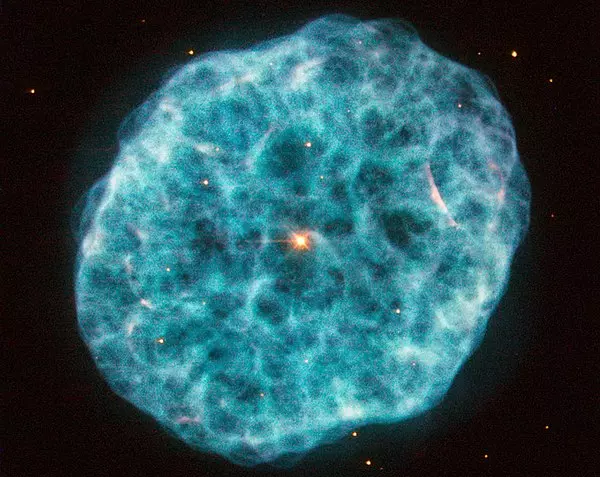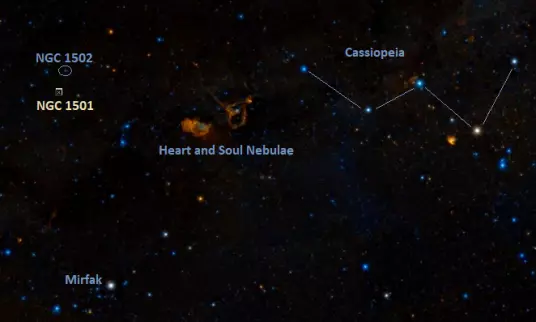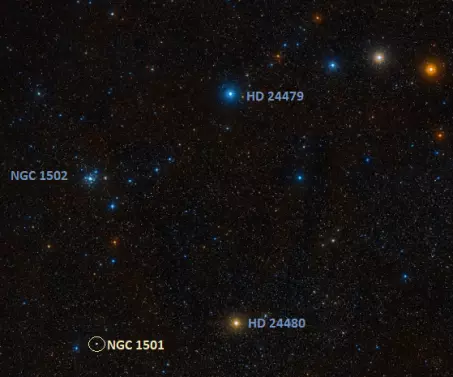The Oyster Nebula (NGC 1501) is a planetary nebula located in the northern constellation Camelopardalis, the Giraffe. The nebula was created by an extremely hot, rapidly pulsating central star in a very late stage of its life. Appearing as a bright orange dot in the centre of the glowing cloud of dust and gas, the star looks like a pearl in a large celestial oyster, giving the nebula its name.
The Oyster Nebula lies at an estimated distance of 4,240 light years. It has an angular size of 0.863 arcminutes and an apparent magnitude of 13.0. It was discovered by the German-born British astronomer William Herschel on November 3, 1787.
Once described as “bearing a resemblance to the convolutions of the brain” by American astronomer Francis G. Pease, the structure of NGC 1501 is characterized by a bubbly appearance and moderately elliptical shape. The ellipsoid is distorted by a pair of large bipolar lobes along the major and intermediate axes, with many smaller bumps on the whole surface.

Oyster Nebula (NGC 1501), image: ESA/Hubble & NASA; acknowledgement: Marc Canale
A 2000 study explained the nebula’s morphology in terms of interaction of the low-velocity nebular material with the powerful, fast wind from the progenitor star. Images taken in the R-band revealed a diffuse envelope around the main body of the nebula, extending up to 34 arcseconds from the central star.
The progenitor star is unusual in that it varies in brightness, which is something not commonly found in planetary nebulae. It has the variable star designation CH Camelopardalis. Even though it ejected its outer layers a long time ago, the star is still very hot and luminous, and appears to be pulsating. Data collected by the Gaia space observatory suggests that it is part of a binary system. The star shows very rapid variations in brightness, changing dramatically over a period of just half an hour. The General Catalogue of Variable Stars lists it as a RPHS variable (very rapidly pulsating hot subdwarf B star) of the spectral type WC4, with a visual magnitude of 14.4 at maximum brightness.
In a 1983 study, Iben et al. suggested a born-again scenario for CH Camelopardalis, in which the star experienced a late thermal pulse and expelled the hydrogen-rich layers, exposing the core after it had already reached the cooling sequence as a white dwarf.
The star is losing mass at a rate of 5.2 x 10-7 solar masses per year through a strong stellar wind with terminal velocities of 1,800 or 3,300 km/s-1.
Location
The Oyster Nebula lies in Camelopardalis, a faint constellation in the far northern sky. Camelopardalis does not have any particularly bright stars that could be used to find the nebula, but the five bright stars that form Cassiopeia’s W can be used for orientation.

Oyster Nebula location, image: Wikisky
The Oyster Nebula is located in the same region of the sky as the Heart and Soul nebulae. It can be found south of Kemble’s Cascade, an asterism consisting of more than 20 stars that form a straight line stretching across 3 degrees (five times the full Moon diameter). The brightest star in Kemble’s Cascade is catalogued as HD 24479 and has an apparent magnitude of 4.95. The line of stars ends with the open cluster NGC 1502, nicknamed the Jolly Roger Cluster. The cluster has an apparent magnitude of 6.9 and is 20 arcminutes across. The Oyster Nebula lies 1.4 degrees south of the cluster.

Oyster Nebula, Kemble’s Cascade and NGC 1502, image: Wikisky
The nebula is visible in 4-inch telescopes with an OIII or UHC filter, but it is best observed in larger instruments. In 5-inch telescopes, it appears as a faint bubble. 10-inch telescopes will reveal a glowing bubble with a round disc and an annular structure around the object at high magnifications.
Camelopardalis is visible throughout the year in the northern hemisphere. The best time to observe the Oyster Nebula and other deep sky objects in the constellation is during the winter months, when the Giraffe rises high above the horizon in the evening sky.
Oyster Nebula – NGC 1501
| Constellation | Camelopardalis |
| Right ascension | 04h 06m 59.3919688584s |
| Declination | +60° 55′ 14.277444117″ |
| Apparent magnitude | 13.0 |
| Apparent size | 0.863’ |
| Distance | 4,240 light years (1.3 kiloparsecs) |
| Parallax | 0.5673 ± 0.0253 mas |
| Names and designations | Oyster Nebula, NGC 1501, PN G144.1+06.1, PN G 144.5+06.5, PK 144+6.1, H 4.53, CS 14.4, GC 801, CH Camelopardalis, BWE 0402+6047, GCRV 2334, IRAS 04026+6047, 2MASS J04065939+6055143, PLX 894.00, NVSS J040659+605514, ARO 44, VV 16, VV’ 22, WD 0402+607, WN B0402.6+6047, Gaia DR2 473712872456844544 |